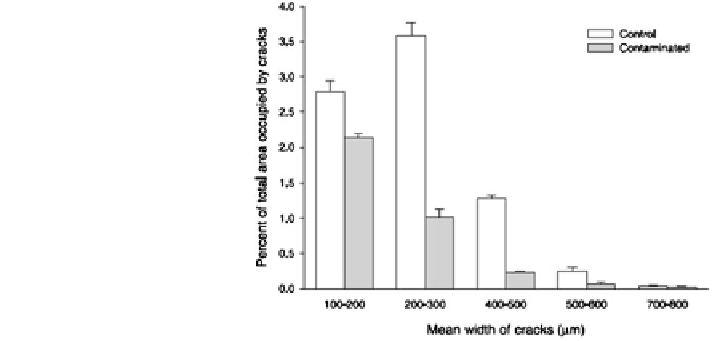Geoscience Reference
In-Depth Information
Fig. 18.49 Size distribution
of cracks of a soil in response
to contamination by
hydrocarbons. Bars represent
standard error for each
measure (n = 4) (Caravaca
and Roldán
2003
) Reprinted
from Caravaca and Roldán
(
2003
). Copyright 2003 with
permission from Elsevier
within large pores. Because these heavy kerosene residues are not easily biode-
graded on a human lifetime scale, we can expect such porosity changes to be
essentially irreversible.
Water transport properties of soils may be changed irreversibly following
hydrocarbon contamination. The extent of the changes is controlled by the type of
soil and pollutant properties. Irreversible effects on water transmission properties
are related to the retention of petroleum products in the soil-subsurface matrix.
Hydrocarbon products can be retained in the porous matrix by entrapment in the
pore network and/or by sorption at particle surfaces. Physical and chemical
properties of the soil-subsurface solid phase, including hydration status, mineral
content, and organic matter content, control the degree of hydrocarbon entrapment
and sorption.
Caravaca and Roldán (
2003
) examined changes occurring to soil texture and
porosity following contamination by petroleum hydrocarbons. These authors
considered an extreme case of soil pollution near an oil refinery in the province of
Murcia (Spain), which released uncontrolled amounts of hydrocarbon over nearly
10 years. The total soil organic carbon (TOC) increased during this period from
7.2 to 73.8 g/kg. In contaminated soil samples, Caravaca and Roldán (
2003
) found
a decrease in the clay faction from 33 to 21 %, relative to the natural soil, and an
increase in sand fraction from 45 to 58 %. Soil macroporosity (defined as pores
[50 lm) in the hydrocarbon-contaminated soil increased about 15-fold compared
with that in the control soil, affecting water transport in the soil-subsurface system.
This modification is reflected also in the pore size classes.
Shrinkage of the soil was determined by Caravaca and Roldán (
2003
)tobe
higher in the control plot than in the soil contaminated by hydrocarbons. More-
over, the size distribution of cracks in the control soil differed from the contam-
inated soil (Fig.
18.49
).
Soil water-holding capacity and water repellency are additional factors that
should be considered in relation to soil water transmission properties. The effect of
varying petroleum hydrocarbon contamination on the hydraulic properties of

